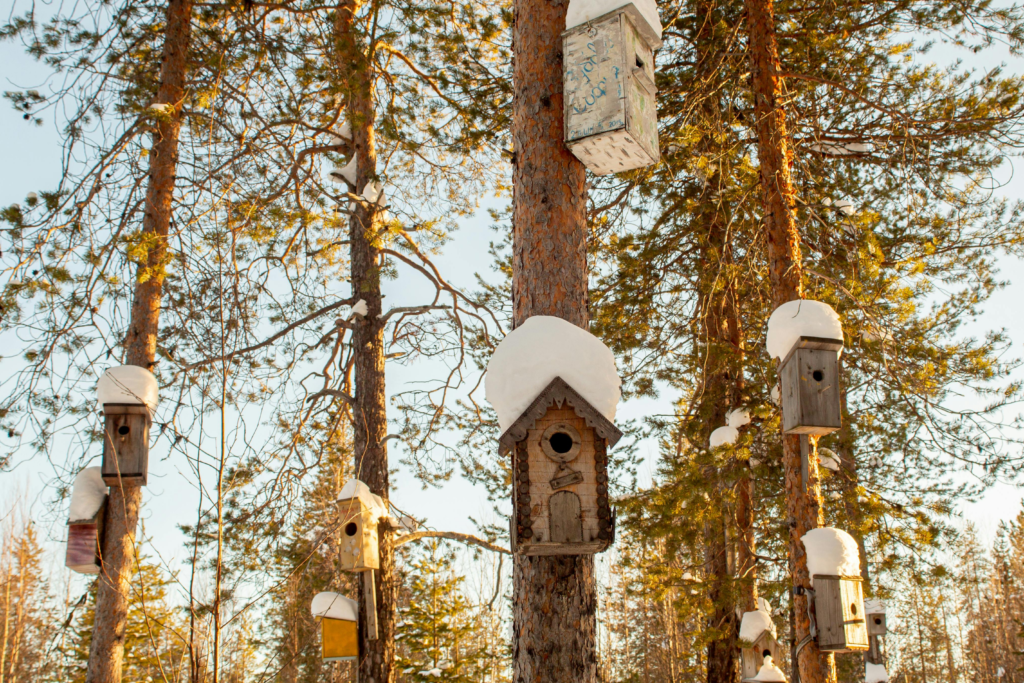
I love watching birds in my backyard. Building birdhouses is a fun way to help them. It’s rewarding to see birds make a home in a birdhouse I built.
If you enjoy woodworking or want to try it, this article is for you. We have lots of birdhouse plans and ideas. You can pick a classic or something more creative to attract your favorite birds.
Choosing the Right Birdhouse Design
Starting a birdhouse woodworking project means picking the right design to attract birds. It’s important to know what birds you want to attract. Each bird has its own needs and likes.
Before you start with wooden birdhouse patterns and plans, think about a few things:
Consider the Bird Species You Want to Attract
Each bird species needs something different for their homes. Bluebirds like open spaces and specific sizes. Wrens are more flexible and can live in many birdhouses. Knowing which birds live in your area and what they like will help you pick the best birdhouse design.
Determine the Ideal Birdhouse Size and Entrance Hole Dimensions
After picking the bird species you want, figure out the right birdhouse size and entrance hole. Here’s a guide for some common birds:
| Bird Species | Floor Area (in inches) | Entrance Hole Diameter (in inches) | Height Above Ground (in feet) |
|---|---|---|---|
| Bluebirds | 5 x 5 | 1.5 | 5-10 |
| Wrens | 4 x 4 | 1.25 | 5-10 |
| Chickadees | 4 x 4 | 1.125 | 5-15 |
Choosing the right size and entrance hole for your bird species will help attract them. This will give them a cozy place to nest.
Now that you’ve thought about these things, you’re ready to look at birdhouse plans. Next, we’ll talk about the materials and tools you’ll need to make your birdhouse.
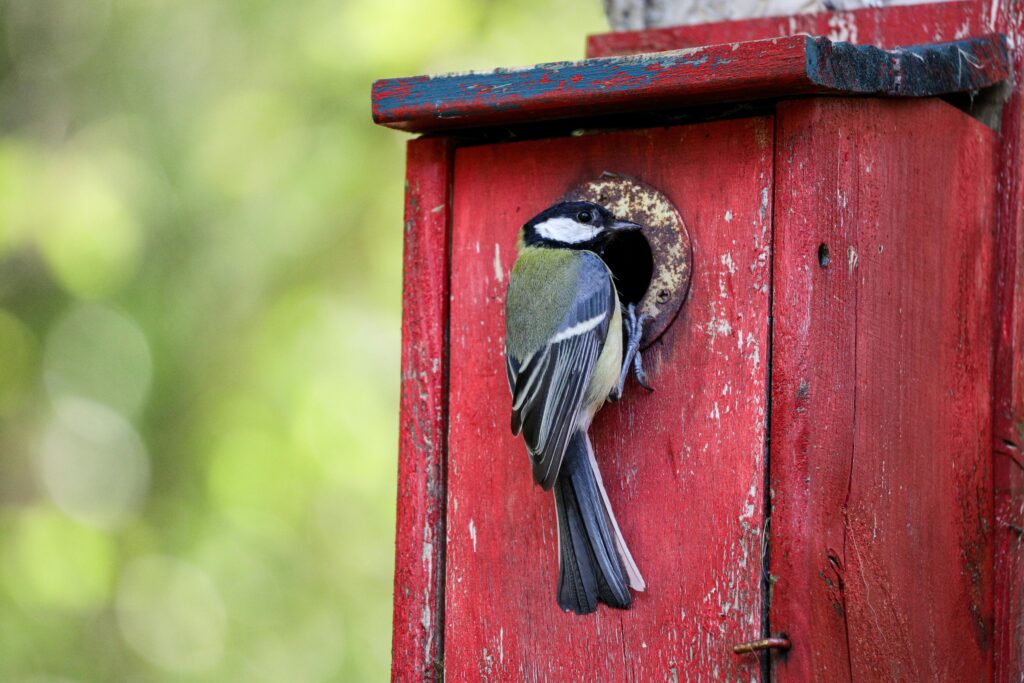
Basic Birdhouse Construction Materials
Starting a birdhouse project means picking the right materials and tools. The wood you choose and the tools you use greatly affect the birdhouse’s quality. This includes how well it keeps birds warm and safe.
Wood Types Suitable for Birdhouses
Choosing the right wood is key for a birdhouse that lasts. Cedar, redwood, and cypress are top picks because they resist decay and bugs well. They also keep the inside cozy for birds. But, avoid treated wood or plywood because they can harm birds.
Here’s a table comparing common woods for birdhouses:
| Wood Type | Durability | Insulation | Resistance to Decay |
|---|---|---|---|
| Cedar | High | Excellent | High |
| Redwood | High | Good | High |
| Cypress | High | Good | High |
| Pine | Moderate | Moderate | Low to Moderate |
Woods to AVOID:
❌ Pressure-treated lumber (toxic chemicals harm birds).
❌ MDF/particleboard (swells when wet).
❌ Oak (too heavy and splits easily outdoors).
Pro Tips:
- Use untreated, unpainted wood inside the birdhouse (birds peck at walls).
- Add a sloped roof and drainage holes to prevent water buildup.
- Avoid metal roofs (overheats nests).
Essential Tools for Building a Birdhouse
You’ll need a few key tools to build a birdhouse. A saw for cutting wood, a drill for holes, a hammer for putting it together, and a screwdriver for screws. A measuring tape and square help with precise cuts and alignment. These tools are crucial for a birdhouse that’s both strong and useful.
Make sure your tools are ready for the job. Sharp saw blades, well-maintained drill bits, and a sturdy hammer will help you work more efficiently. With the right materials and tools, you’ll create a warm home for birds.
Simple Birdhouse Plans for Beginners
Building your own birdhouse is exciting and rewarding. Start with simple guides and plans that are easy to follow. These require minimal tools and materials. You can make a cozy space for birds to nest and raise their young.
Look for beginner-friendly designs that use common materials and basic techniques. These projects can be done in a few hours. They’re great for weekend projects or family activities. As you get better, you can try more complex designs.
One-Board Birdhouse Design
The one-board birdhouse is easy to make. It uses a single board, usually 1×6 or 1×8. This design is simple and efficient, reducing waste and needing only basic cuts and assembly.
To make a one-board birdhouse, follow these steps:
- Cut the board to 12-14 inches long.
- Mark and cut the angled roof pieces at each end.
- Cut the front and back panels to the right height.
- Drill an entrance hole in the front panel, sized for the bird species you want to attract.
- Assemble the pieces with wood glue and small nails or screws.
Classic Birdhouse with Sloped Roof
The classic birdhouse with a sloped roof is another easy option. It has a simple rectangular body and a slanted roof for shelter and drainage. The roof adds charm and character to the birdhouse.
To build this birdhouse, you’ll need basic supplies like wood boards, a saw, a drill, and fasteners. Most plans include detailed instructions and cut lists, making it easy for beginners.
When picking wooden birdhouse patterns, choose ones that fit the bird species you want to attract. Different birds need specific entrance hole sizes, interior dimensions, and mounting heights. It’s important to research and pick a design that meets their needs.
Starting with these simple plans will help you create a welcoming habitat for birds. As you get more experience, you can try more advanced designs and techniques. This way, you can make unique and personalized bird homes for your feathered friends.
Unique and Creative Birdhouse Ideas
Make your backyard more charming with creative birdhouses that show off your style. Use recycled items like paint cans, milk jugs, and boots to make birdhouses. This not only adds beauty but also helps the environment.
When using recycled materials, make sure they are safe for birds. This means good airflow, drainage, and non-toxic materials.
Think outside the box with your birdhouse designs. Katia Tolstykh’s Orator Birdhouse uses a copper loudspeaker and oak wood. Michael Hilgers’ Birdball is made from recycled plastic.
Get inspired by mid-century modern or rustic designs. Sourgrassbuilt’s Sunset Modern Birdhouse and Moger Mehrhof Architects’ Log Quartered Birdhouse are great examples.

Make your garden unique with personalized birdhouses. Artist Nishant Jethi’s alphabetic birdhouses are a great idea. Chrome Dome Studio’s Airstream Birdhouse is a nod to classic designs.
Turn liquor bottles into birdhouses with Larry Keisling’s design. QueenBeeAndMrMan’s Space Jet Teapot Birdhouse is a fun, whimsical choice.
For a natural look, try a teardrop-shaped birdhouse from woven bamboo. It’s perfect for woodpeckers and sparrows. These ideas show how you can create unique homes for your backyard birds. It’s a great way to show your creativity and welcome birds to your garden.
Decorative Birdhouse Designs
Make your backyard more beautiful with decorative birdhouse designs. You can choose from rustic charm to whimsical and vintage styles. These designs fit your garden’s unique look.
Rustic Birdhouse with Natural Elements
Rustic birdhouses use wood, stone, and clay. They look great in gardens and help birds. These birdhouses are made from natural materials like bark and leaves.
They are safe for birds because they don’t have harmful chemicals. Rustic birdhouses help your garden and the birds living there.
Colorful and Whimsical Birdhouse Designs
Colorful birdhouses make your garden fun and lively. They attract many birds and look great. You can find birdhouses shaped like cottages or fairy tale castles.
These designs make your garden more interesting. They also help different birds live together. Make sure the birdhouses are safe and comfortable for the birds.
Vintage-Inspired Birdhouse Creations
Vintage birdhouses remind us of the past. They look like old cottages or barns. They add elegance to your garden.
These birdhouses are not just for birds. They also make your garden look better. Use old wood and special finishes to make them look vintage.
| Birdhouse Style | Key Features | Benefits |
|---|---|---|
| Rustic | Natural materials, bark, twigs, leaves | Blends with environment, safe for birds |
| Whimsical | Bright colors, unique shapes, imaginative themes | Attracts various species, enhances visual appeal |
| Vintage-inspired | Classic architecture, distressed finishes, antique colors | Evokes nostalgia, serves as a focal point |
Birdhouse Designs and Plans for Specific Bird Species
When making a birdhouse, think about what each bird needs. Tailor your avian nesting box instructions to attract specific birds. This way, you’ll increase the chances of them choosing your birdhouse as their home. Use diy birdhouse guides and bird home construction plans for each species to build the best home for them.
Bluebird House Plans
Bluebirds are great visitors to backyards. To help their numbers, build a bluebird house. Use untreated wood and make the entrance hole 1.5 inches wide. The inside should be about 5×5 inches, with a depth of 8-12 inches.

Hang the birdhouse 5-6 feet up, in a spot with some trees or shrubs around.
Wren Birdhouse Designs
Wrens are lively and love birdhouses. For wrens, make a birdhouse with a 1-1.25 inch entrance hole. The inside should be 4×4 inches, with a depth of 6-8 inches. Make sure the roof slopes for water to run off.
Put the wren house 5-10 feet up, near thick shrubs or in a quiet corner.
Purple Martin House Plans
Purple martins live in groups, so they need special houses. For purple martins, build a house with many compartments. Each should be 6×6 inches, with a 2-inch entrance hole. The house should be 18-24 inches tall, on a strong pole or platform.
Place the martin house in an open spot, 10-15 feet up, away from trees or buildings.
By following these avian nesting box instructions and diy birdhouse guides, you can make welcoming homes for your favorite birds. With the right bird home construction plans, you’ll soon see bluebirds, wrens, and purple martins in your yard.
Repurposing Items into Birdhouses
Turning everyday items into birdhouses is a smart and green way to help local wildlife. You can use things like teapots, cups, and gourds to make homes for birds. This method not only saves materials but also helps birds by giving them safe places to nest. Plus, it makes your garden look unique and creative.
Transforming Gourds into Unique Birdhouses
Gourds are great for making birdhouse woodworking projects because they last long and break down easily. First, pick a dry, mature gourd and remove the seeds and pulp. Then, cut a hole for the birds that’s big enough for them to get in but small for predators. Once it’s clean and dry, hang it up in a spot like a tree branch or post. This gives birds a natural place to nest.
Using Teapots and Cups as Birdhouse Bases
Turning teapots and cups into birdhouses is fun and helps the environment. For a teapot birdhouse, pick a strong one with a lid and handle. Drill holes for drainage and for the birds to get in. Hang it up on a post or branch, making sure it’s safe from bad weather. Cups can be attached to saucers to make a base, then mounted like teapots. This gives birds a cute place to stay. These projects let you be creative while helping birds in your yard.
Mounting and Placement Options
Choosing the right spot for your functional bird housing plans is key to attracting birds. The location of your birdhouse greatly affects the safety and comfort of the birds. Here are some tips for mounting and placing your decorative bird box designs effectively.
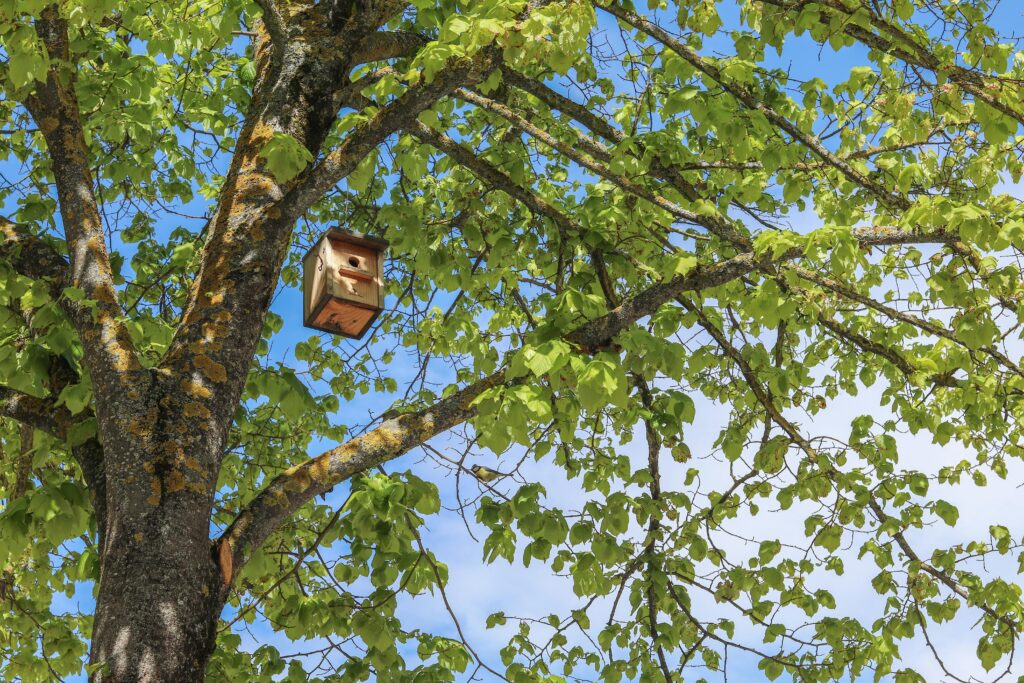
Hanging Birdhouses from Trees or Poles
Hanging birdhouses from trees or poles is a common choice. It lets you place the birdhouse at the right height for the birds you want to attract. Use a strong chain or wire to hang it from a tree, to keep it steady in the wind. For a pole mount, pick a spot that’s shaded and safe from predators.
Installing Birdhouses on Fences or Walls
You can also mount your birdhouse designs and plans on fences or walls. This is great for a sturdy and lasting setup. Use screws or brackets to attach the birdhouse securely. Make sure the entrance faces away from the wind and is easy for birds to get to.
It’s important to place your birdhouses in a safe and welcoming spot. Don’t put them too close to people or where predators can get them. By carefully choosing where to put your decorative bird box designs, you can make a cozy home for birds in your yard.
Maintaining and Cleaning Birdhouses
To keep birdhouses healthy for nesting birds, regular upkeep is key. Unlike House Wrens, Bluebirds don’t clean out old nests themselves. This can lead to disease, parasites, and predators reaching eggs or nestlings. Old nests can carry bacteria and mites, spreading diseases and deterring new birds from nesting.
Check bird boxes at least once a year, in February or March. Make sure they’re sturdy, upright, and securely attached. Also, check that squirrels haven’t enlarged the opening. Cleaning birdhouses once a year, preferably in fall, is best7. This keeps them safe for birds and extends their life.
When cleaning, use a putty knife or spatula to remove old nests and debris. For lice, spray with weak bleach solution and let dry. Use mild soap or vinegar to scrub the inside, avoiding harsh chemicals. Dispose of the old nest far away to avoid attracting predators.
- Never reach into a birdhouse to remove an old nest if you cannot see clearly inside; use a tool instead5
- Wear a face mask to avoid inhaling dust or detritus5
- Sanitize your hands immediately after handling a nest5
- Do not attempt a nest change after the babies are fully feathered (about 13 days old) as they may prematurely fledge5
By following these bird house blueprints for maintenance and cleaning, you can create a safe and inviting environment for birds to nest and thrive in your avian nesting box. Remember to clean your birdhouses at least once a year, with a focus on cleaning prior to the nesting season.
Key Takeaways:
- Explore a variety of birdhouse designs and plans for different bird species
- Learn about essential materials and tools for building durable birdhouses
- Discover creative ideas for repurposing items into unique bird homes
- Gain insights on proper birdhouse placement and maintenance
- Attract native birds to your backyard with well-crafted avian nesting boxes
Conclusion
Building your own birdhouses is a fun and rewarding project. It helps both you and the birds in your backyard. By choosing the right plans and materials, you can create a safe home for different bird species. This brings joy to your outdoor space and helps the environment.
When you start building, think about which birds you want to attract. The size of the entrance hole matters a lot. For example, a 2.5 cm hole is good for marsh tits, while a 3 cm hole attracts great tits.
Use durable materials like untreated wood. Also, place the birdhouse in a spot that’s safe from predators and bad weather.
Building birdhouses is a fun adventure. You can try out different designs and patterns. This lets you be creative and help your local bird population. Remember to keep your birdhouses clean and well-maintained. This way, birds will have a cozy home all year round.
So, get your tools ready and pick your favorite plans. Start building a bird-friendly haven in your backyard today!
FAQ
What should I consider when selecting a birdhouse design?
When picking a birdhouse design, think about the bird species you want to attract. Also, figure out the right size and entrance hole for them. Different birds need different homes for nesting.
What types of wood are suitable for building birdhouses?
For building birdhouses, pick durable woods like cedar, pine, or redwood. These woods are weather-resistant and comfy for nesting birds.
What are some simple birdhouse plans for beginners?
Beginners can start with simple designs like a one-board birdhouse or a classic one with a sloped roof. These designs are easy to make and cozy for birds.
How can I add a touch of personality to my birdhouses?
To make your birdhouses unique, try creative ideas. Use recycled materials, unusual shapes, or themed designs. This makes your birdhouses stand out and functional.
What are some decorative birdhouse design ideas?
Decorate your backyard with birdhouses that are more than just homes for birds. Try rustic designs, colorful whimsical ones, or vintage looks. These birdhouses add charm to your garden.
Can I tailor my birdhouse designs to specific bird species?
Yes, you can design birdhouses for specific species like bluebirds, wrens, or purple martins. Each bird has its own nesting needs, so make sure your design meets theirs.
What everyday items can I repurpose into birdhouses?
Get creative by turning everyday items into birdhouses. Use gourds for natural homes or teapots and cups for charming bird homes. It’s a fun and eco-friendly way to help birds.
What are the best mounting and placement options for birdhouses?
Think about where to put your birdhouses. You can hang them from trees or poles, or install them on fences or walls. The right spot makes birds feel safe and secure.
How often should I maintain and clean my birdhouses?
Keep your birdhouses clean and well-maintained for the birds. Remove old nests, clean inside, and check for repairs. This keeps the birdhouses healthy and inviting.
Or if you’d rather just buy a Bird House…
Sisterbird Wren Bird House
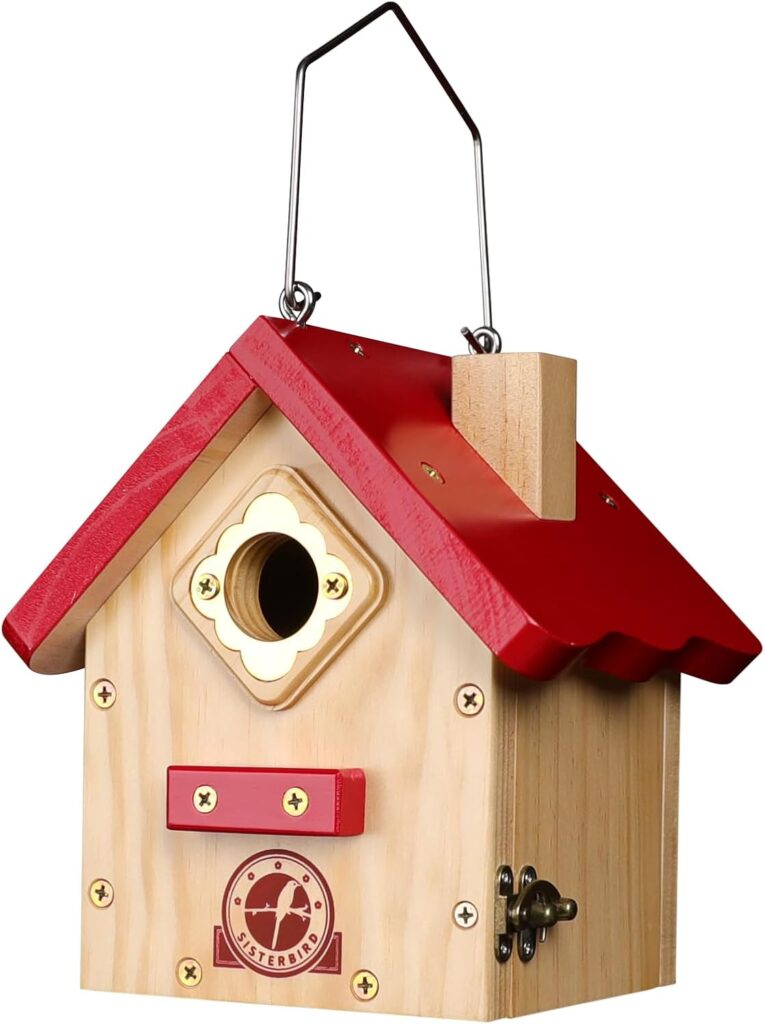
Wren Bird House, Premium Wooden Bird Houses for Outside, Classic Cabin Design Birdhouses for Outdoors, Hanging Bird House, Red-Breasted Nuthatch Wren Chickadee, click here for details
Sisterbird 2 Pack Bird Houses (Assembly Required)
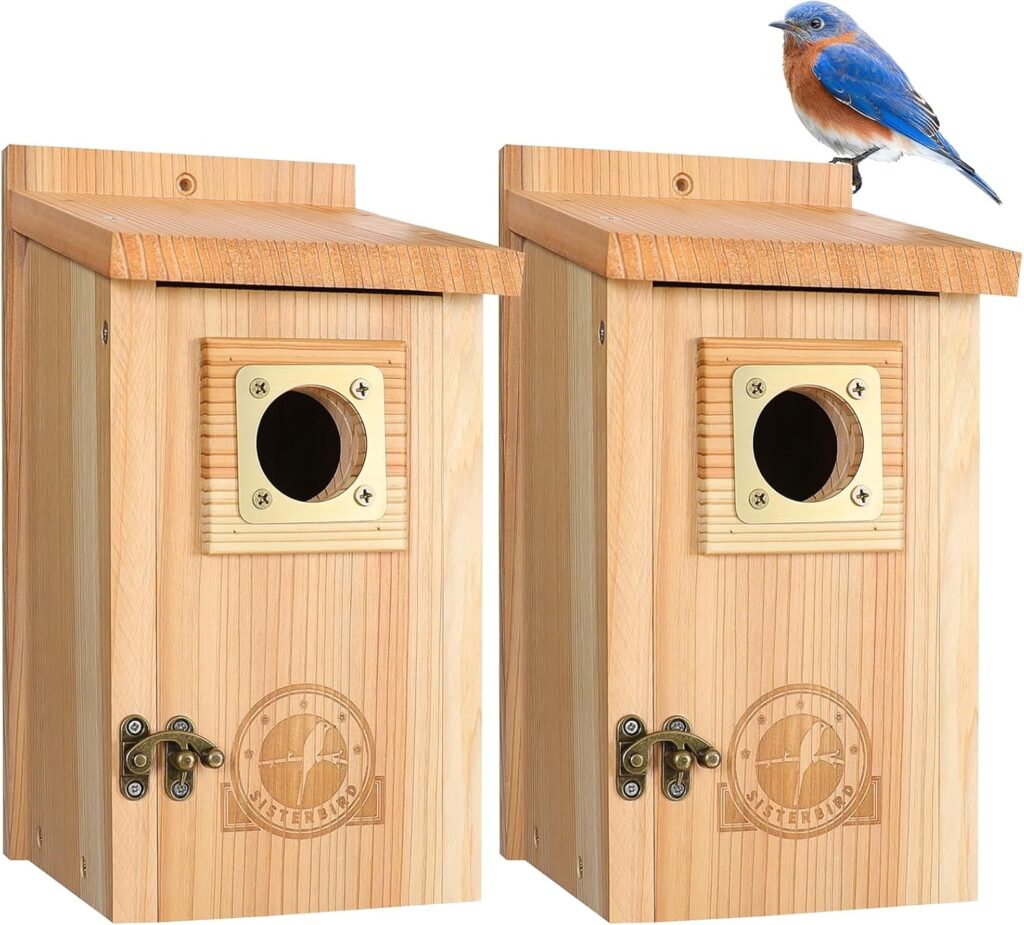
Outside Clearance with Copper Guard, Cedar Bird House Outdoor, Bluebird Finch Swallow Wren Chickadee Assembly Required, click here for details
Photo Credits: I want to thank the amazing photographers whose work we used in this article, these pros are on Pexels where you can also get royalty free photos for your posts, please visit their sites today:
Nadia Vasil’eva, LePei Visual & Laura and Vincent Delsuc



